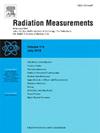Charge carrier release mechanisms underlying the emission of alkali feldspar infrared stimulated luminescence
IF 1.6
3区 物理与天体物理
Q2 NUCLEAR SCIENCE & TECHNOLOGY
引用次数: 0
Abstract
Within a recent experimental study we reported that ultraviolet measurements of infrared stimulated luminescence (IRSL) from a variety of alkali feldspars are characterised by the common presence of fast and slow pulse components. We interpreted our observations as indicating the presence of charge carrier processes associated respectively with electrons and alkali ions. Within our present study we utilise the defect pair model we have employed within earlier quartz studies in order to seek physical explanations for the underlying mechanisms. For this purpose, we argue that the most likely source defect is a trivalent charge-compensated titanium dimer. Within our model, we propose complementary defect reaction pairs that involve the respective release of electrons and alkali ions. Our analysis, which is concentrated on the charge carrier release mechanisms, involves the construction of appropriate configurational coordinate diagrams which we utilise in order to explain the origin of the fast and slow IRSL components and also that of infrared photoluminescence (IRPL).
碱长石红外激发发光的载流子释放机制
在最近的一项实验研究中,我们报告了来自各种碱长石的红外激发发光(IRSL)的紫外测量,其特征是快速和慢速脉冲成分的共同存在。我们将我们的观察解释为表明分别与电子和碱离子相关的电荷载流子过程的存在。在我们目前的研究中,我们利用我们在早期石英研究中使用的缺陷对模型,以寻求潜在机制的物理解释。为此,我们认为最可能的源缺陷是三价电荷补偿钛二聚体。在我们的模型中,我们提出了涉及电子和碱离子各自释放的互补缺陷反应对。我们的分析集中在载流子释放机制上,涉及到适当的构型坐标图的构建,我们利用这些坐标图来解释快速和慢速IRSL组件以及红外光致发光(IRPL)的起源。
本文章由计算机程序翻译,如有差异,请以英文原文为准。
求助全文
约1分钟内获得全文
求助全文
来源期刊

Radiation Measurements
工程技术-核科学技术
CiteScore
4.10
自引率
20.00%
发文量
116
审稿时长
48 days
期刊介绍:
The journal seeks to publish papers that present advances in the following areas: spontaneous and stimulated luminescence (including scintillating materials, thermoluminescence, and optically stimulated luminescence); electron spin resonance of natural and synthetic materials; the physics, design and performance of radiation measurements (including computational modelling such as electronic transport simulations); the novel basic aspects of radiation measurement in medical physics. Studies of energy-transfer phenomena, track physics and microdosimetry are also of interest to the journal.
Applications relevant to the journal, particularly where they present novel detection techniques, novel analytical approaches or novel materials, include: personal dosimetry (including dosimetric quantities, active/electronic and passive monitoring techniques for photon, neutron and charged-particle exposures); environmental dosimetry (including methodological advances and predictive models related to radon, but generally excluding local survey results of radon where the main aim is to establish the radiation risk to populations); cosmic and high-energy radiation measurements (including dosimetry, space radiation effects, and single event upsets); dosimetry-based archaeological and Quaternary dating; dosimetry-based approaches to thermochronometry; accident and retrospective dosimetry (including activation detectors), and dosimetry and measurements related to medical applications.
 求助内容:
求助内容: 应助结果提醒方式:
应助结果提醒方式:


